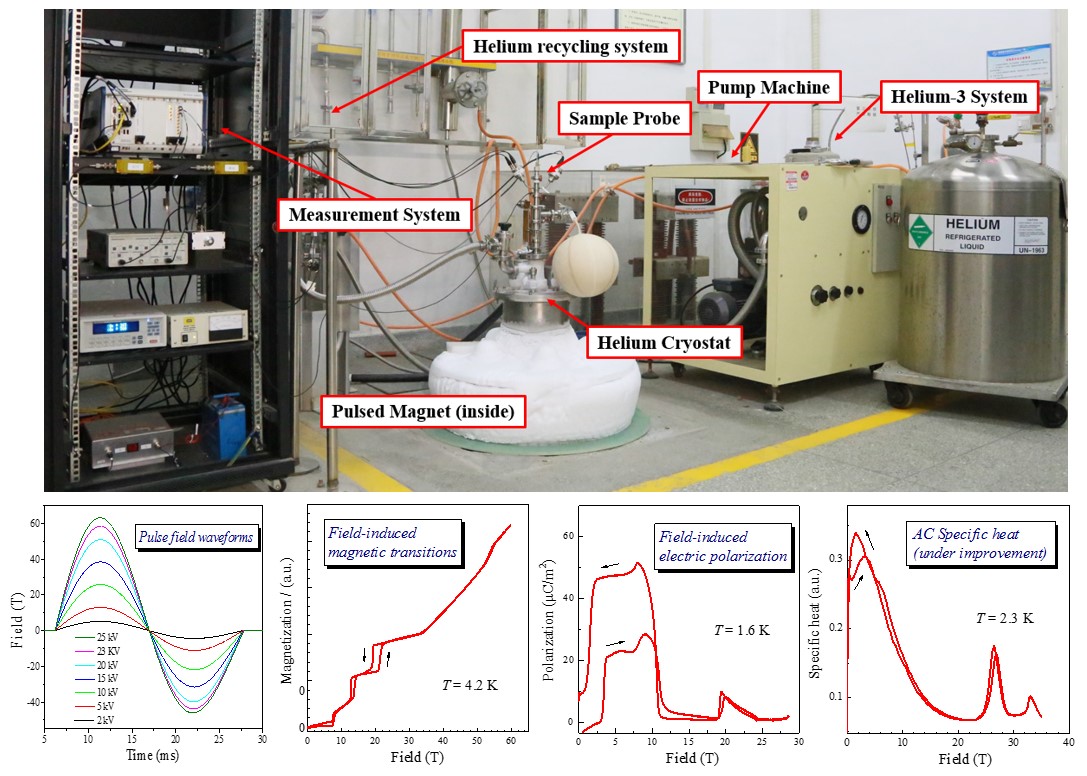- Facility
- Measurement stations
- Auxiliary facilities
Measurement stations
The magnetization measurement station is one of the most important experimental systems for pulsed high field facilities in the world. It is very popular because many materials show magnetic phase transitions and novel magnetic properties in very high magnetic fields. The magnetization in a pulsed field is measured by an induction method using a well-compensated pick-up coil. The dM/dt signal from the sample was collected and integrated after comparison of the results for sample-in and sample-out with two different pulse shots. In addition to the high strength of magnetic fields, this technique takes other two distinct advantages in comparison with the measurement in a steady field. It is very sensitive to detect weak magnetic phase transitions due to its very short measuring time (~10 ms) and the high-speed (>250 k/s sampling rate) data acquisition system. Spin dynamic issues can be studied in such high field-sweeping rate of 103-105 T/s. Our facility also offers opportunities to measure the high-field magnetic properties such as electric polarization, magnetostriction, torque etc. associated with the field-induced magnetization transitions.

(1) Magnet and magnetic field
Bore |
Capacitor |
Duration |
Cooling time |
Peak field |
|
23 mm |
1.25 MJ |
6-10 ms |
35 min |
65 T |
|
23 mm |
2 MJ |
60 ms |
40 min |
60 T |
(2) Sample temperature
·Helium 4 system: 1.5-300 K
·Helium 3 system: 0.4-1.5 K
(3) Experiment Technique
·Magnetization by a compensated pick-up coil
·Electric polarization by detection of the pyroelectric current
·Magnetic hysteresis loop from -50 T to 65 T
·Electric transport by a digital lock-in method
·Magnetostriction using optical method (under improvement)
·Magnetic torque by a cantilever (under improvement)
·de Haas-van Alphen oscillation by an induction method (under improvement)
·Specific heat by ac technique (under improvement)
(4) Measurement equipment
·National Instruments PXI-5105, 5412, 5922, PXIe-8135, 6672, 1062Q
·Keithley 2000, 2182, 2400, 6221, 6487, LakeShore 330, 335
·Stanford Research System SR850 digital lock-in amplifier, SR560 amplifier
·Wayne Kerr 6500B (120 MHz) impedance analyzer
(5) Sample preparation and characterization
·FZ-T-10000-H optical floating zone furnace
·X’Pert powder diffraction meter (XRD, Netherlands)
·WS22 high precision wire saw (Princeton Scientific Corp.)
·7 T superconducting quantum interference device (SQUID)
·16 T quantum design physical property measurement system (PPMS)
(6) Related publications
·B.R. Chen, Z.C. Xia et al., Engineering of ion-doping on the ground states and Bose-Einstein condensation of Sr3Cr2O8. Mater. Chem. Phys. 167, 278 (2015)
·N.M. Xia, L.R. Shi, Z.C. Xia et al., Dynamic behavior of magnetoelectric coupling of CuFeO2 induced by a high magnetic field. J. Appl. Phys. 115, 114107 (2014)
·L.R. Shi, Z.C. Xia et al., The enhanced spontaneous dielectric polarization in Ga doped CuFeO2, J. Appl. Phys. 116, 173907 (2014)
·Z.C. Xia et al., Avalanche transition with super-bandwidth magnetic field response in (La0.73Bi0.27)0.67Ca0.33MnO3. Appl. Phys. Lett. 102, 192408 (2013)
·J.F. Wang et al., High magnetic field induced phases and half-magnetization plateau in the S=1 kagome compound Ni3V2O8. Phys. Rev. B 84, 220407(R) (2011)
(7) Staff contact


